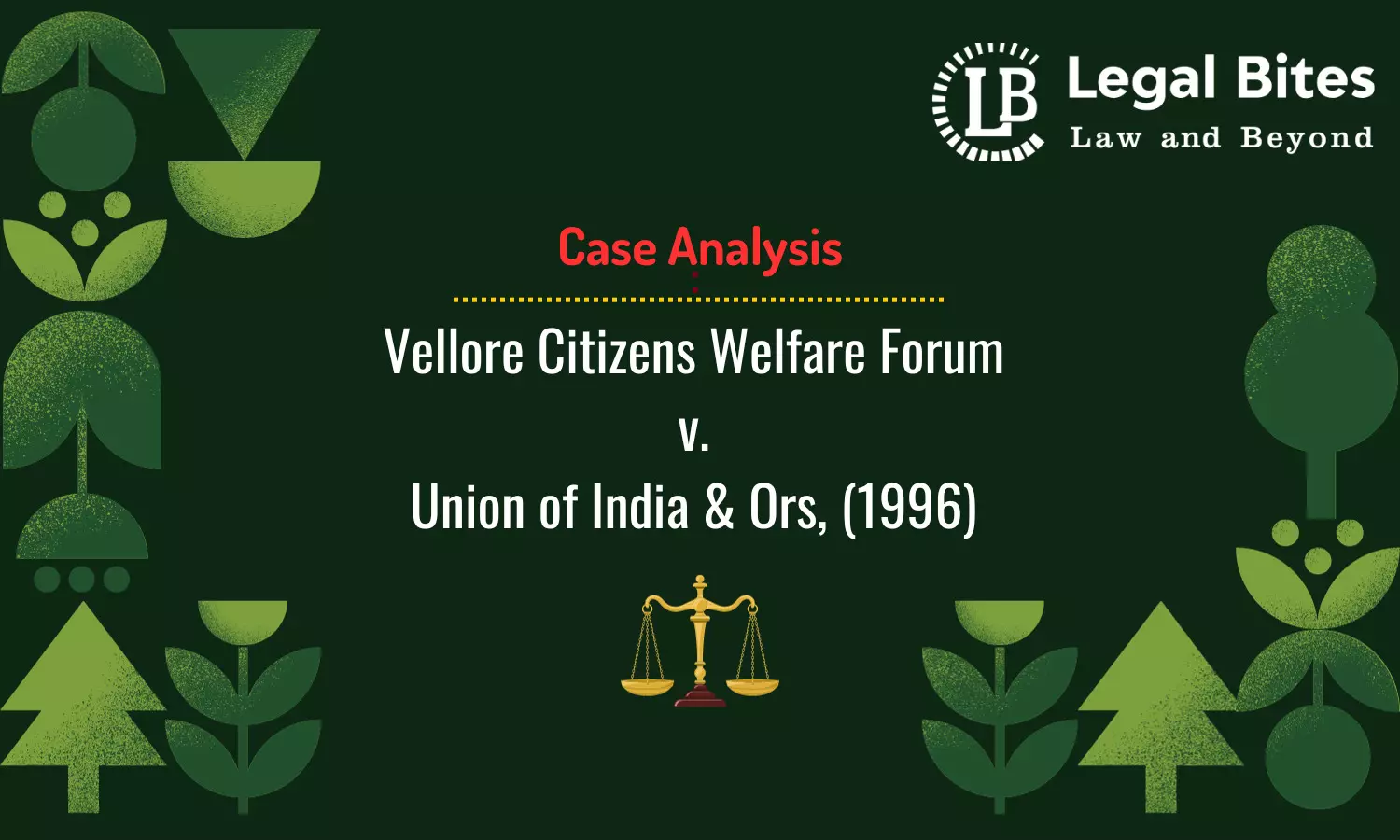Case Analysis: Vellore Citizens Welfare Forum v. Union of India & Ors, (1996) | Significance of the 'Precautionary Principle' & the 'Polluter Pays Principle'
The Case Analysis 'Vellore Citizen's Welfare Forum v. Union of India' contains a remarkable decision of the Supreme Court highlighting the balance between industrial development and environmental protection.

The Case Analysis 'Vellore Citizen's Welfare Forum v. Union of India' contains a remarkable decision of the Supreme Court highlighting the balance between industrial development and environmental protection. Further, the case explains correct issues like damage caused by the tanneries to its surrounding water bodies and the livelihood in Tamil Nadu. It turned out that of 584 tanneries, only 443 had the government's consent to discharge their sewage in the nearby water bodies.
Case Title: Vellore Citizens Welfare Forum v. Union of India
Court: Supreme Court of India
Citation: (1996) 5 SCC 647
Judges: Justice Kuldip Singh, Justice Faizan Uddin, and Justice K. Venkataswami
Date of Judgment: 28/08/1996
Facts
- Vellore Citizen's Welfare Forum, an NGO has filed a case against the tanneries and other industries in Tamil Nadu for discharging unrefined sewage in the river Palar, the agricultural lands, waterways, and roadsides.
- River Palar being the primary source of water supply to the residential area, the petitioner claimed the bottom of the river and the subsoil of the river were polluted, which could not be made available to the residential area.
- The Agricultural Research Centre observed that the sewage had made nearly 35,000 hectares of agricultural land unfit for cultivation. The polluted land contained large quantities of dyes and 170 types of chemicals like sulphuric chloride, liquor, and ammonia.
- In a survey conducted by the Peace Members, one found out that the amount of wastewater discharged daily contained acids and chemicals in the coming years would cause unimagined environmental damages.
- The survey also learned that these tanneries neglected the impact on the health of humans, animals, and agricultural lands.
- The written petition was filed under Article 32 of the Indian Constitution for a pollution-free environment by focusing on two international terms related to sustainable developments: Polluter pays principle - the principle is about making a party take responsibility for their action for producing pollution and make them compensate for the environmental harm done. The court asked the authority to calculate the compensation to be paid by the polluter for the people it harmed and the ecology. The court can shut down the industry if the polluter does not reimburse the payment. Precautionary principle - any harm caused to human lives and the environment, immediate protection to be taken before any scientific proof of risk is identified.
Issue
Do the tanneries have permission to continue working at the risk of the welfare of their surrounding nature and the lives of individuals?
Contention of the Parties
The petitioners argued that river Palar is intoxicated, making it unfit for consumption. The study found that the tanneries have caused ecological damage in Tamil Nadu, contaminating around 350 wells used by the villagers to consume drinking water.
Meanwhile, the respondents argued that the Board's Total Dissolved Solids ("TDS") quality was not legalised. The National Environmental Engineering Research Institute ("NEERI") examined the issue for the court. NEERI found that the Ministry of Environment and Forest provided no guidelines for the inland surface water and release of TDS, sulphate, and chlorides—the State Pollution Control Boards met through appropriate control measures and wastewater treatment plants.
Judgment
The court agreed the leather industry is an essential part of the nation's development, as it employs the people of the country and results in foreign exchange. However, development and environmental preservation shall be a balanced process. These tanneries damage ecology and are a threat to human life. The apex court ordered tanneries to stop their operation until they install pollution control equipment. After installation, if they get approved by the Tamil Nadu Pollution Board, they could continue their work. The court recommended Rs 50,000 must be given to MC Mehta for his appreciable task. Green Benches must be established in order to increase rapid protection towards issues related to the environment.
The Court directed the Central Government to create an authority in accordance with the provisions outlined in Section 3(3) of the Environment (Protection) Act, 1986.
Conclusion
The judgment talks about the protection of the environment and human lives. The concepts of Sustainable development, Polluter pays, and Precautionary principle are essential to be understood by individuals. This judgment and other judgments like M.C Mehta v. Union of India and more indicate economic development is a crucial factor for a country, but doing it at the cost of destroying the environment to such an extent that it is not repairable. Thus, a country needs to create a balance between economic development and environmental protection.
Contributions from: Shruti Roy And Apurva Neel

